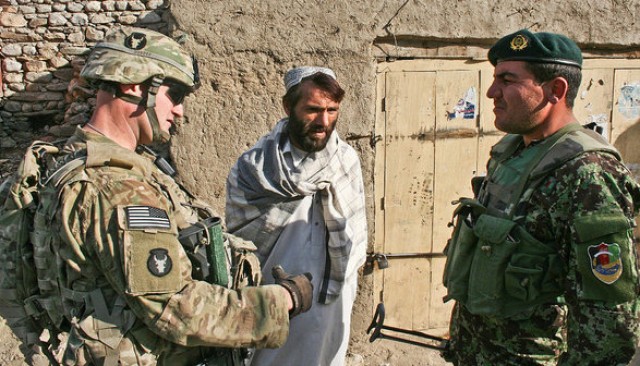
GHAZIABAD, Afghanistan (Dec., 26, 2010) -- Whenever someone moves into a neighborhood, it's traditional to go meet one's new neighbors.
In a sense, that's what Company A, 1st Battalion, 133rd Infantry Regiment, and 1st Company, 1st Battalion, 201st Afghan National Army (ANA) Regiment Soldiers were doing, Dec. 26, when they conducted a key leader engagement in the town of Ghaziabad, Afghanistan.
"This was the first time we had been to this particular village. We really didn't have any information on it," said Staff Sgt. Kevin Ott, an infantryman with Company A, 1st Bn., 133rd Inf. Regt., who is also trained in civil affairs and performs that role on missions. "We went there and introduced ourselves and tried to identify the key leaders of the village. They always try to feel you out on the first visit."
The mission was a joint patrol between ANA and their coalition counterparts, said 1st Lt. John Dundee, 1st platoon leader for Company A, 1st Bn., 133rd Inf. Regt., who led the mission from the coalition side. He said the mission is typical of a daily patrol the units conduct together. Dundee said that while the village of Ghaziabad has not presented any problems for Afghan or coalition forces thus far, while Watangatu, a nearby village, has been a haven of enemy activity.
"We also wanted to talk with the people and find out what they know about insurgent activity in the area or the improvised explosive devices that have been detonated a mile or so away from them," said Dundee. "We try to gather as much information as we can. They gave us a lot of points on where the enemy goes to or where they come from."
The town is about six miles south of Combat Outpost Najil, where Company A has been deployed since November, and is one of several small villages on the way to Mehtar Lam, the next large village. Prior to the coalition's presence in the area, the route to Mehtar Lam had been unpaved.
Khir Mohammed, one of the elders who spoke with Ott, expressed gratitude from the townspeople to the Afghan and coalition forces, saying the paved road cuts the trip time from Ghaziabad to Mehtar Lam from a full day's travel, to an hour trip.
"This helps thousands of our people," Mohammed said.
Ott said the road is now theirs, and in order to keep the free flow of travel open and to protect the people of the village, the townspeople need to contact the coalition when they see enemies planting IEDs on it.
Mohammed also expressed concerns of his townspeople. Though Ghaziabad is large and well-developed compared to many other towns, Mohammed said the town would like to eventually put in a school of their own, because many of the children go to school in Watangatu, a dangerous area. Mohammed also expressed concern over the distance between the town and medical facilities.
Ott said it was important to go to Ghaziabad to show the people the ANA and coalition forces are there to help secure the area.
"We don't know what the villagers have heard about us, and unless we go there, we can't tell them who we are and what we're about," he said.
Dundee also said he was pleased with the mission, as the villagers were very open and receptive to the Soldiers, whereas in the past, getting people from a village to speak openly may take several visits. Though it was only an initial meeting, the Afghan and coalition forces opened a line of communications with another village in the area.

Social Sharing